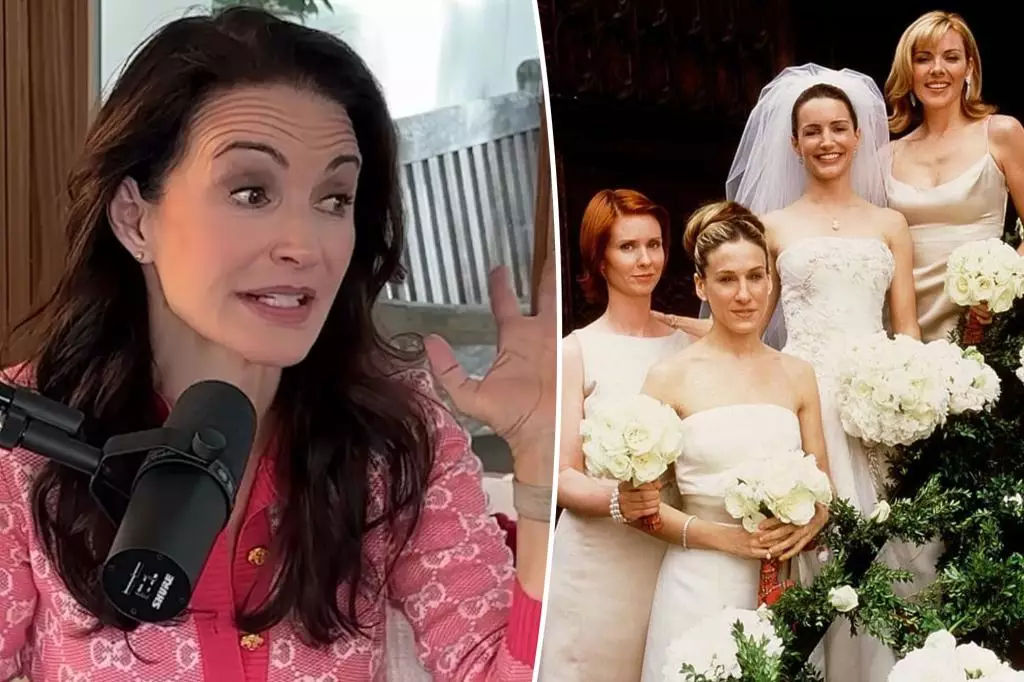The cultural phenomenon of “Sex and the City” continues to resonate with audiences, thanks to its vibrant portrayal of friendship, love, and fashion. However, behind the glitzy facade of New York City and the beautiful designer outfits lies a complex array of interpersonal dynamics, particularly among its star-studded cast. Recently, Kristin Davis, who embodied the character of Charlotte York, revealed a wardrobe dispute that may have left a lasting impression on her co-star Sarah Jessica Parker, the beloved Carrie Bradshaw. This incident goes beyond petty disagreements, showcasing how creative differences can sometimes sour professional relationships.
The crux of the dispute revolves around a seemingly innocuous choice of color: beige. While filming the pivotal wedding scene in Season 3, Sarah Jessica Parker reportedly voiced her dissatisfaction with the bridesmaid dress she had to wear for Charlotte’s wedding. Davis brought this moment to light during her discussion with showrunner Michael Patrick King on the podcast “Are You a Charlotte?”. She claimed that Parker “is still mad” about being dressed in beige for the occasion, highlighting an emotional investment that goes beyond mere costume selection.
Parker’s dissatisfaction reportedly escalated to the extent that she chose to alter her Vera Wang dress, transforming it into something that better aligned with her taste. This choice tells a larger story about identity and the importance of self-expression, even within the confines of a television series. Her decision to add tartan elements, inspired by Trey MacDougal’s kilt, was not merely a fashion statement; it illustrated a deeper sentiment regarding autonomy and personal style.
Davis’s recounting of Parker’s frustrations paints an intriguing picture of how the dynamic among the main cast members was far from harmonious during certain filming moments. When Parker approached Davis for support, expressing her bewilderment over being relegated to a bridesmaid’s uniform, it revealed the challenges that can arise in collaborative creative environments. Davis’s response—explaining the thematic appropriateness of the beige dresses—showed her commitment to the narrative integrity of the show. Yet, it also highlights the necessity for open dialogues and compromise; creativity thrives when all voices are acknowledged, even if they clash.
Adding more layers to this narrative, Michael Patrick King characterized the filming of the wedding scene as “one of the longest days of [his] life.” This suggests not only the logistical challenges associated with shooting a complex scene but also the emotional undertones that came with it—a reflection of the multifaceted relationships behind the camera.
Fashion plays an integral role in the storytelling of “Sex and the City,” with characters’ wardrobes reflecting their moods, desires, and stages in life. The beige dresses, for example, symbolized a unity among the bridesmaids and underscored Charlotte’s vision for her wedding day. In stark contrast, Parker’s iconic Vivienne Westwood dress in the quintessential Carrie moment represented individuality and high stakes in her evolving romantic life.
Interestingly, the issue of coordinated outfits reemerges in the films as well. Davis points out that in the highly-anticipated wedding scene between Carrie and Big, there were no matching bridesmaid dresses, a stark departure from Charlotte’s wedding. This artistic decision reflects character growth and changes in the narrative, resonating with the show’s larger themes of personal evolution and friendship in the face of romantic chaos.
The wardrobe debacle between Davis and Parker serves as a stark reminder that the world of show business can be fraught with personal challenges, often masked by the elegance of fashion. The tale offers fans a glimpse into the inner workings of a beloved show, filled with both cooperation and conflict. That the art of television can interlace so tightly with personal dynamics speaks to its emotional depth—and it reminds audiences that behind every glamorous outfit, there’s a story worth telling. The camaraderie forged through creative collaboration might sometimes succumb to disagreements, yet it is this very interplay that enriches the narrative tapestry of storytelling.

